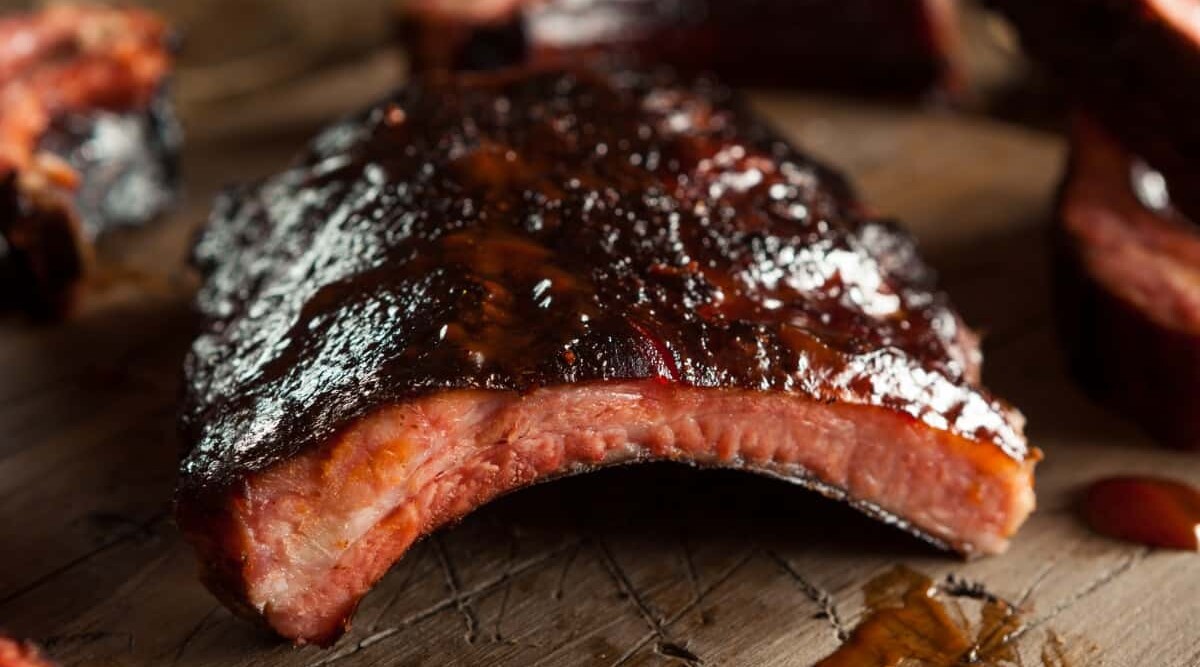
You ask any barbecue aficionado out there what their favorite type of ‘que to eat is and there’s a good chance ribs will make the top 3.
Sure, brisket and pork butt is great, but for many of us, there is no better eatin’ than a rack of glorious, shiny, sticky ribs coated in a sweet barbecue sauce.
If you’re just a beginner, you may not know the difference between each type, or how to cook them. Don’t worry, we’re going give you a quick rundown on the basics of everything swine.
Read on to discover the different types of pork ribs, where they come from on the animal and how you can tell each type apart.
Jump to:
Anatomy of and Different Types of Pork Ribs
Ever wondered where the baby backs and spare ribs are located? Would you be surprised if I told you that they’re both parts of the same rib?
With the different names and cuts it’s easy to get confused but simply put, each pig has between 14 – 16 ribs — depending on the breed — on each side of its body.
The baby backs are at the top and connect to the spine, the spare ribs are attached to the baby backs, and the rib tips make up the bottom of the spares, down by where the bacon is. The three combined are the entire rib and go all the way down the side of the pig from the spine to its belly.
Confused yet? Don’t worry, this video from the good folks at BBQGuys.com will help explain.
Let’s take a look at each rib type in a little more detail…
Baby Back Ribs
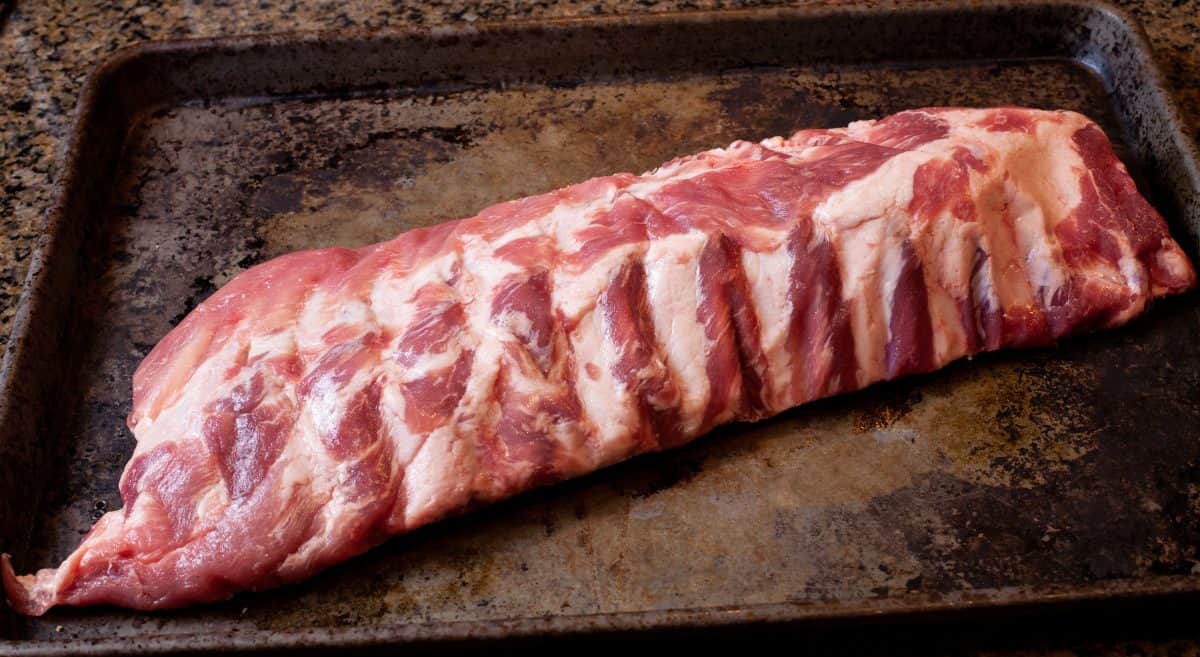
Also known as loin or back ribs, the baby back rib is the part of the rib that is highest on the pig and are connected to the backbone.
As the best-selling author and journalist Daniel Vaughn explains, baby backs do not come from baby pigs. They get their name simply because they’re smaller than the spare rib and are near the top or “back” of the pig.
Baby backs are considered by many to be the “white meat” of the rib. They are a little leaner and more tender than the spares.
A rack of baby backs tapers to one end with bones ranging from 6 inches in length on the long end to 3 inches in length at the other. The bones will bend near the top where they connect to the backbone.
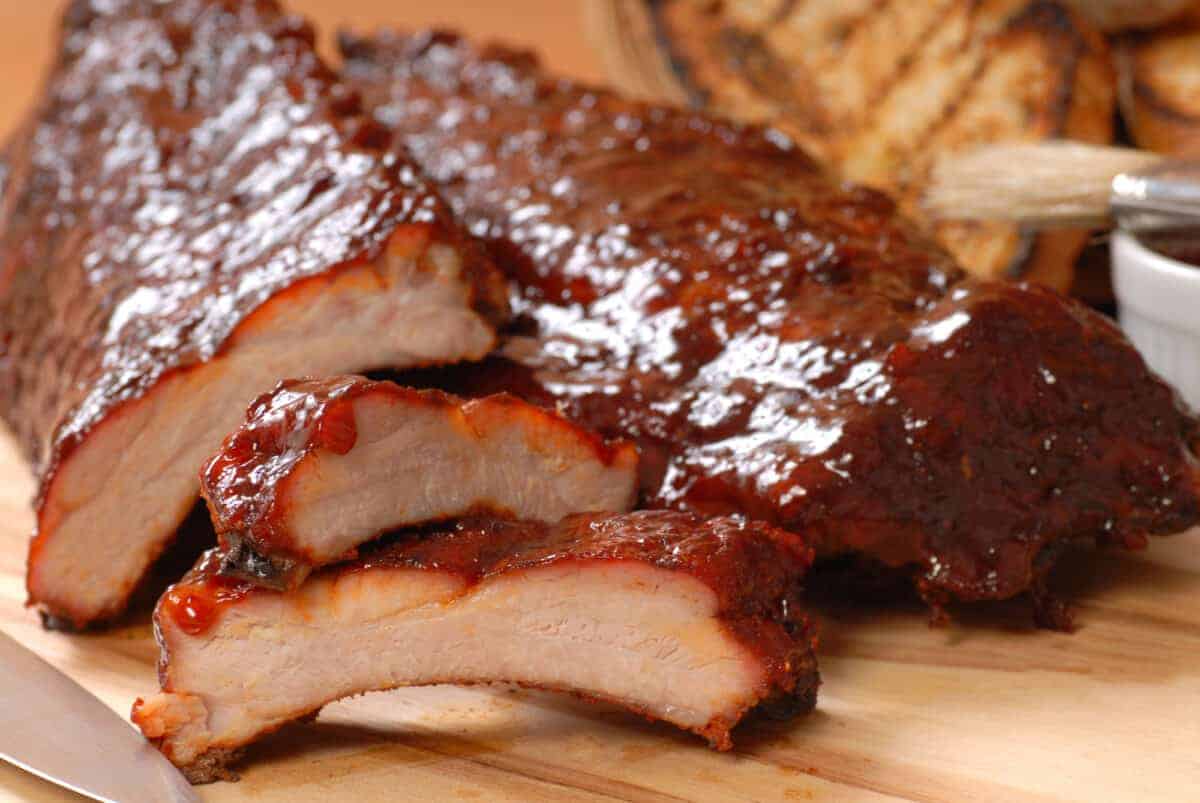
Snake River farms and Crowd Cow sell some excellent baby back ribs that are tender, meaty, full of flavor, and will be sure to impress!
Spare Ribs
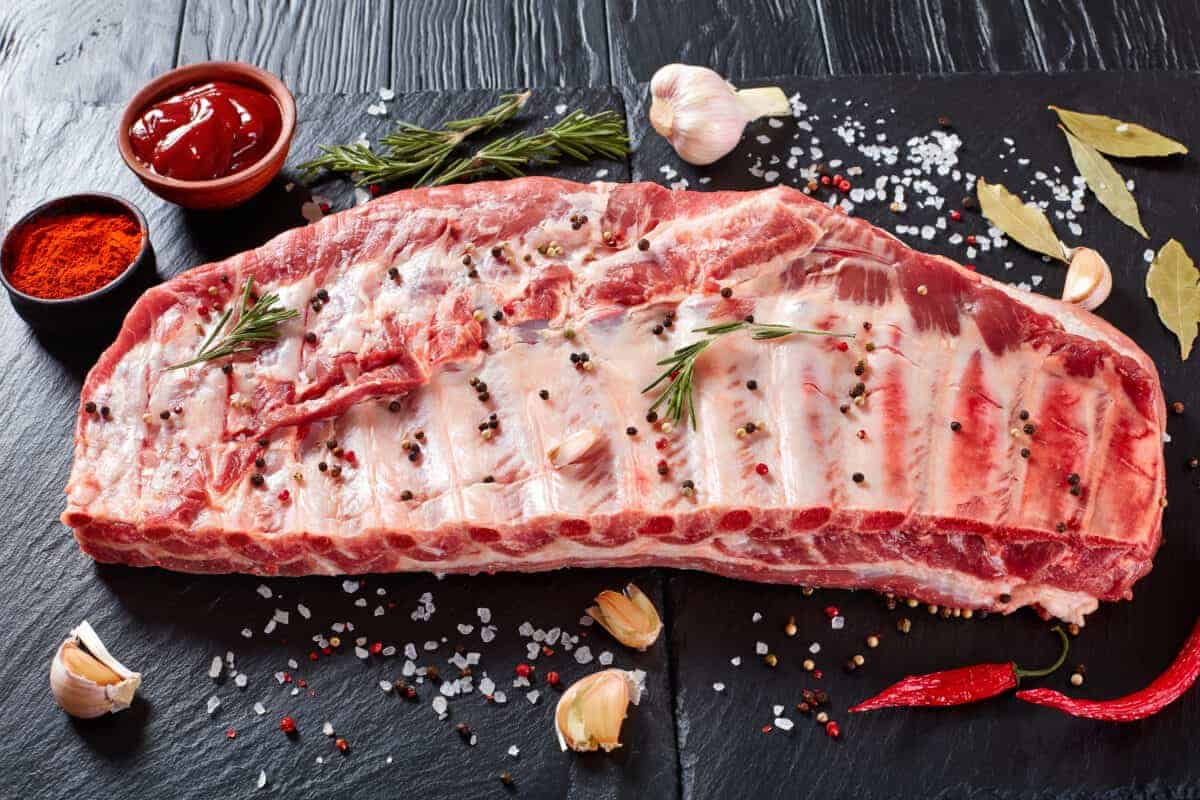
Spareribs seem to be the most popular of the different types of pork ribs and pick up where baby backs left off. They continue the whole way down the side of the pig and meet the breastbone.
The top of the spares shows bone and marrow; this is where the baby backs were cut and separated from the spares.
The bones will continue in a straighter line than baby backs do. The rib bones will stop near the bottom part of the slab. This is basically the chest of the pig and is where the rib tips are found, still connected to the spare rib cut.
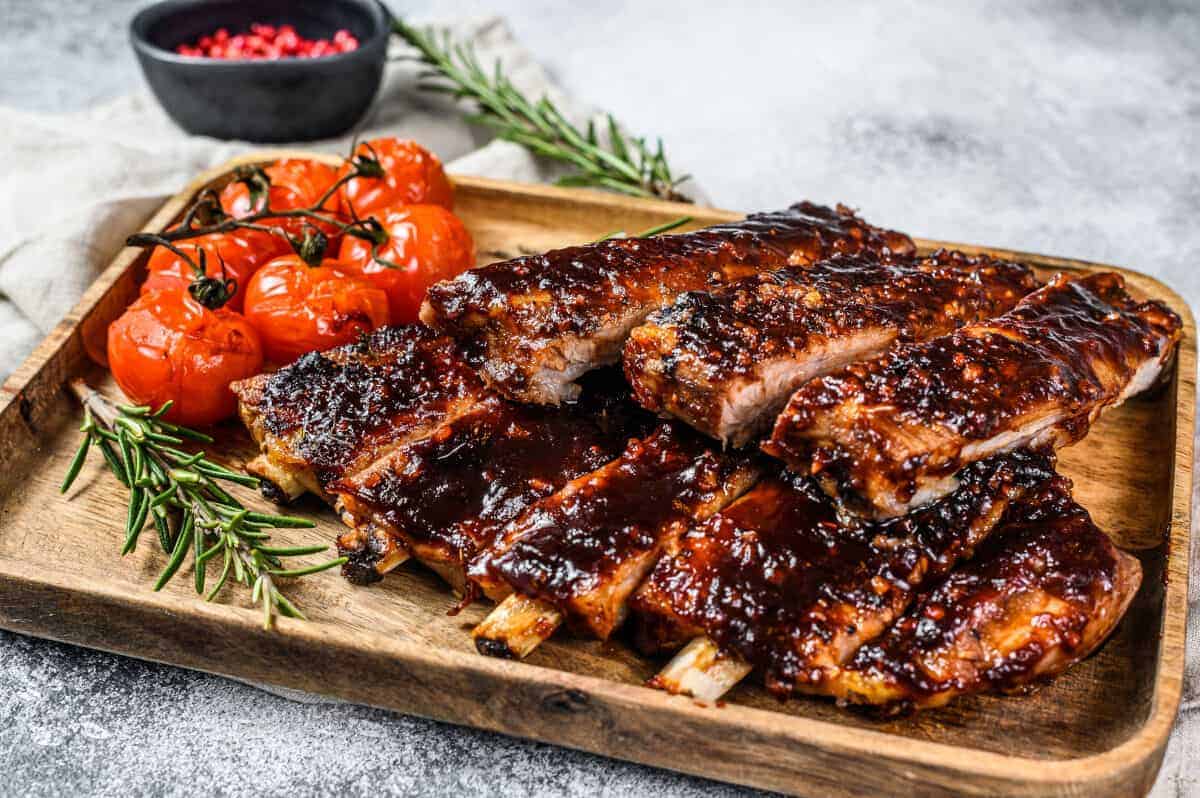
Porter Road and Snake River farms sell meaty spare ribs that are all-natural, hormone free, marbled throughout, and give fantastic flavor.
St. Louis Style Ribs
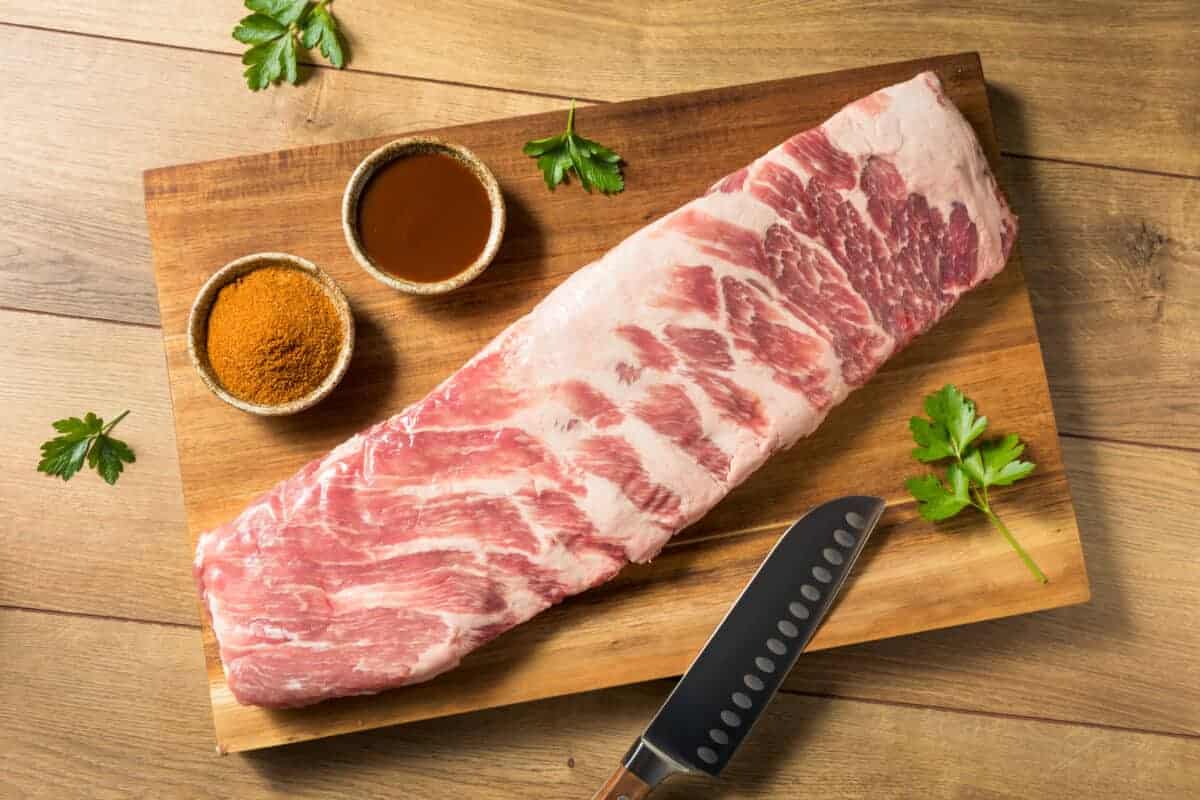
Despite what the name may suggest St. Louis style ribs are not a style of cooking ribs that was popularized in St. Louis, Missouri. In a nutshell, they are the spareribs with the rib tips removed.
The name came from the fact that this cut of pork rib came from the St. Louis meat packers that started preparing this cut in the mid-twentieth century.
This cut has the nice straight rib bones without the messy cartilage and small bones at the bottom. St. Louis ribs tend to be longer than baby backs, and are obviously shorter than full spareribs.
On the competition barbecue circuit, this cut is definitely the preferred cut due to their aesthetically pleasing straight rib bone, but aren’t usually the cut used by backyard cookers.
This would be due to the fact most supermarkets do not sell this cut. Instead, they sell the whole spare rib.

Crowd Cow and Porter Road have quite a selection of meaty St Louis style ribs between them, from multiple different farms, covering pasture-raised, hormone free, and Berkshire Kurobota heritage breed
Rib Tips
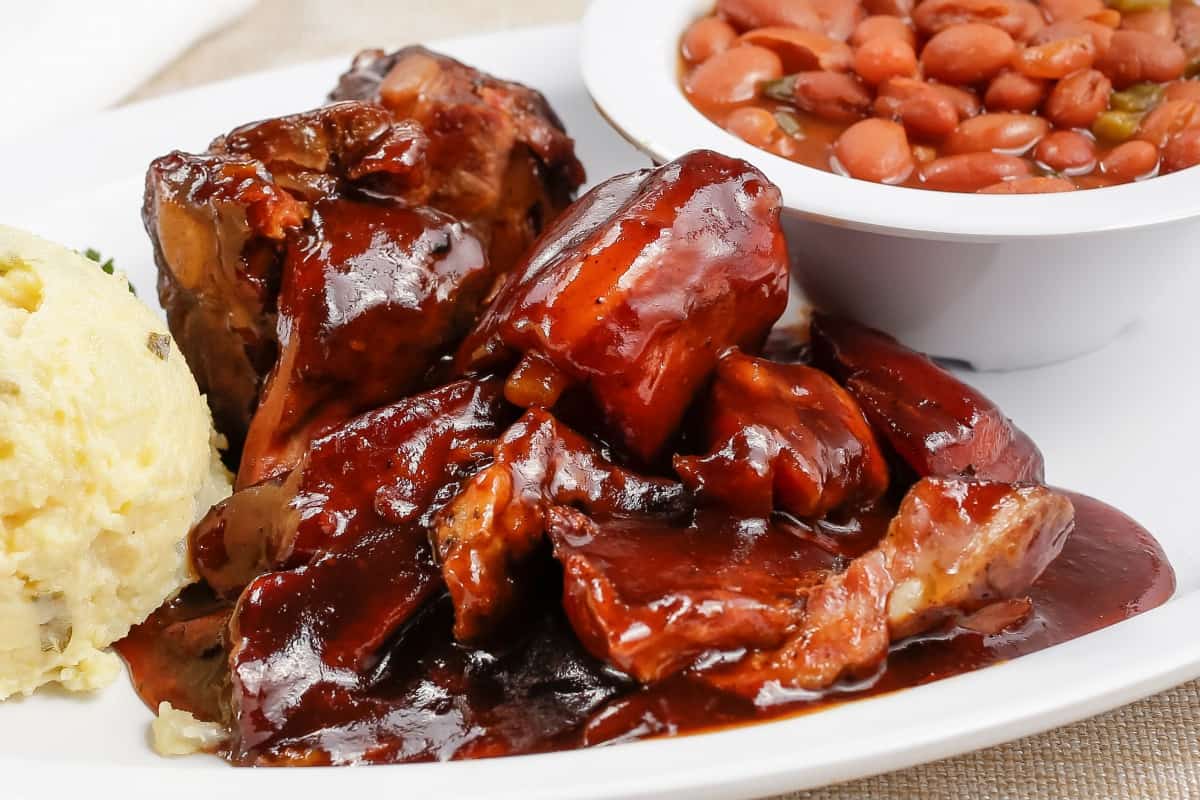
Rib tips are considered by many to be the most tender part of the pig with a lot of fat and marbling. This makes sense, given their close proximity to the belly, aka the bacon. Along with this fat and marbling though is a lot of small bone and cartilage, which can make the rib tips a chore to eat.
Rib tips are trimmed from spare ribs when creating the St. Louis cut.
When separated from the lower end of the spare ribs, they will typically run 8 to 12” long, and 1 to 3” wide.
When served, they will sometimes just be cut into 2” wide chunks with a cleaver and left to the diner to gnaw away at the meat surrounding the small bones and cartilage.
Country Style Ribs
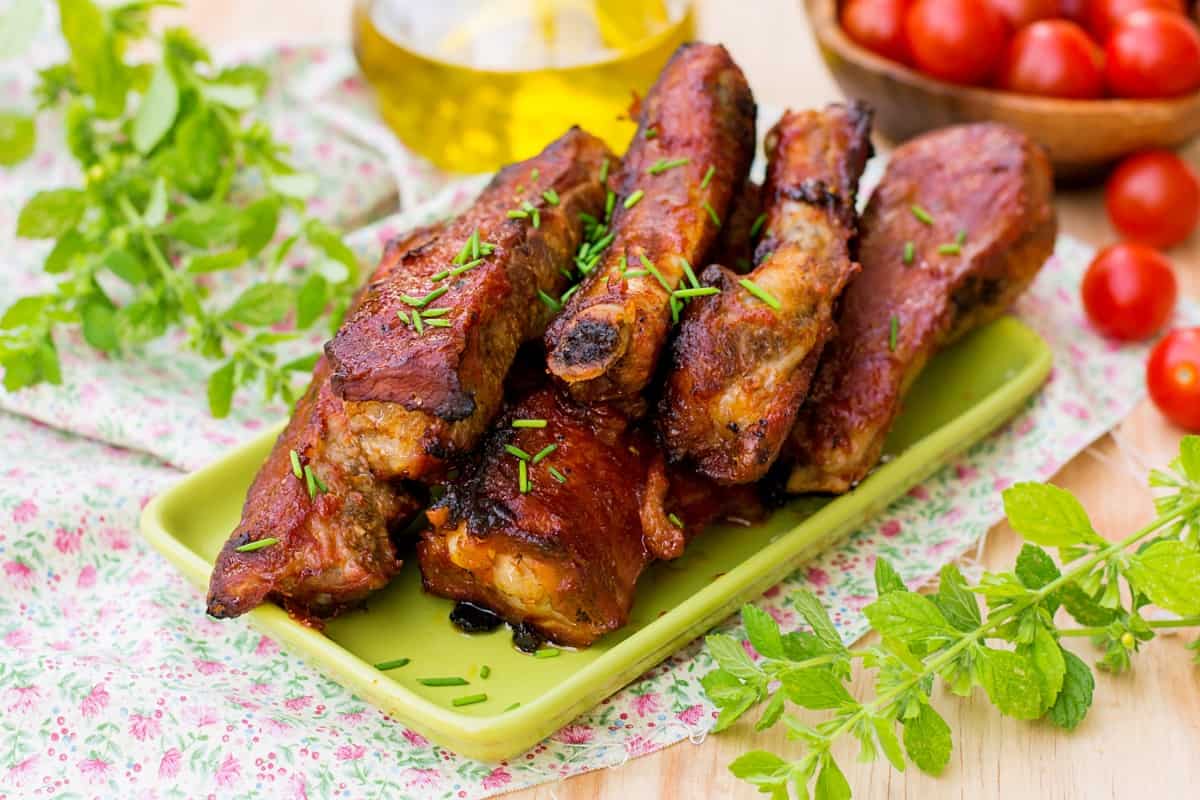
For starters, country style ribs aren’t really ribs; they’re basically a bone-in pork chop cut from the front of the baby back ribs, near the shoulder.
Depending on the size of the hog and how it’s butchered, they may be served with one or two bone thickness, with a lot of pork loin meat attached to them.
For a real treat, try brining them in a simple salt/sugar/water solution overnight, and then cook using the reverse sear method for a melt in your mouth pork chop.
How to Cook Pork Ribs
No matter which cut of rib you choose to cook (with except country ribs), you’re going to cook them virtually the same way.
The most popular method is for 3-2-1 smoked ribs, where they are smoked for 3 hours unwrapped, then 2 wrapped, then a final hour unwrapped and sauced. Though many variations on this exist, and many people prefer not to wrap at all and instead spritz ribs while they cook.
Anyway, enough small talk. Here’s how to grill your pork ribs.
Prepare the Ribs
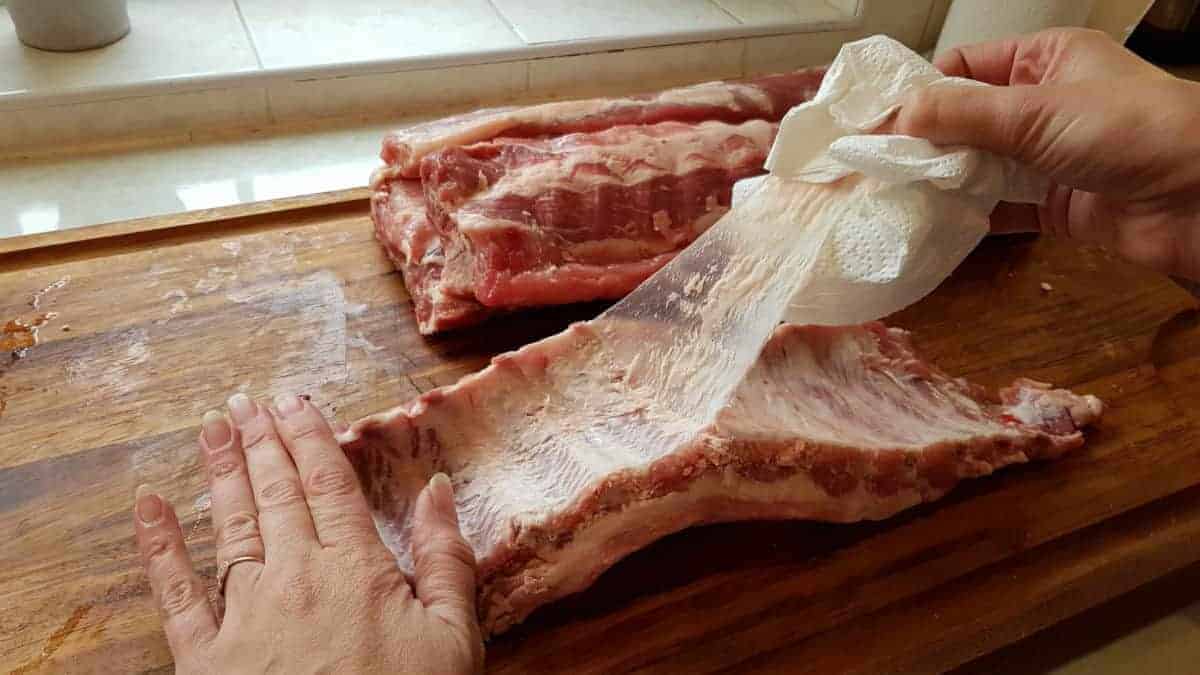
You’ll start by trimming any loose fat or meat that is hanging off the rack. This is done to keep that loose fat or meat from quickly cooking then burning.
On the back of a rack of ribs is a membrane called the peritoneum. You’re going to want to remove it as it will not render away while being cooked.
The best way to do this is to work a butter knife under the membrane and loosen it up, once loosened work your fingers in there with some paper towel and rip the membrane off in one fell swoop.
Lastly, you’ll want to season your ribs with a heavy coating of a sweet rub. Don’t be afraid to be generous here, and get it on all sides.
If cooking rib tips or country ribs there is likely no membrane to remove, so just trim them up, season or brine them, and move on to the next step.
Indirect, Low and Slow
Prepare your grill for two-zone indirect cooking and cook your ribs indirect with a little wood smoke for flavor. Choose your flavor wood carefully, because not all wood is suitable. We have a guide to the best wood for smoking ribs to help you.
Ribs are a little unique in the sense that you’re not going to cook to a finished temperature, but rather you will be cooking them until the meat has cooked to the point of tenderness, and they pull easily off the bone.
If cooking at a temperature of 225 °F – 250 °F, baby backs will take at least 3 – 4 hours. St. Louis and spares will take 5 – 6 hours.
Texas Crutch
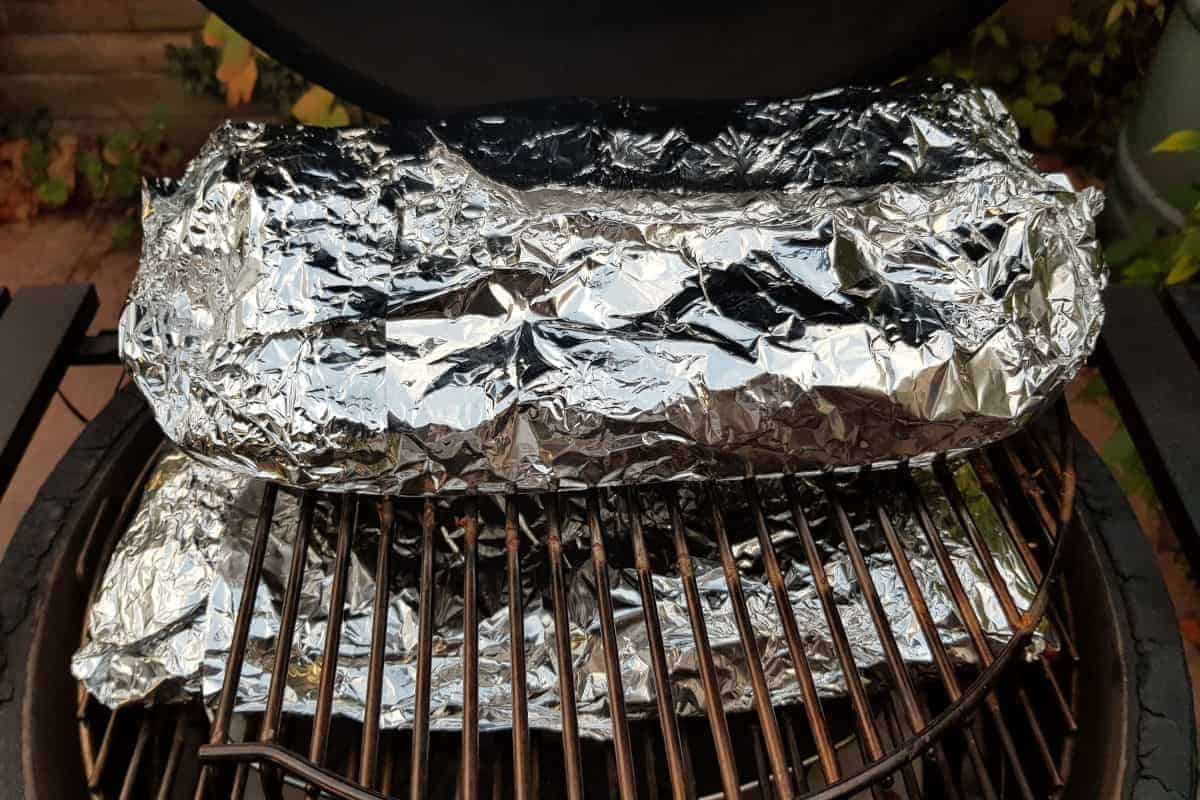
Practically all top competition barbecue teams use the Texas crutch technique for their ribs, pork butt, and brisket.
You smoke your ribs for 3 hours, then you wrap it in foil with a braising liquid for another 2 hours or so, then you take it out of the foil for up to an hour to allow the ribs to “tighten up” on the grill.
Finally, you sauce them and serve.
This step of wrapping in foil with a braising liquid is known as the ‘Texas crutch.’ It’s completely optional, but it can be done to both help speed up the cook and increase the tenderness of the ribs.
By wrapping each rack in tin foil and adding the liquid you are essentially braising them, same as you would braise stew beef in a roasting pan filled with broth.
Sauce and Serve
Much like the Texas Crutch, the decision to sauce your ribs is entirely optional. At Charlie Vergos Rendezvous in Memphis, they’ve been serving baby backs without sauce since 1948.
If you do decide to sauce them, wait until the last 15 – 20 minutes on the grill. Barbecue sauce has a lot of sugar and will easily burn. Apply a tablespoon or two to each rack of ribs, close the lid, and let the sauce set and get tacky.
You can choose to serve your ribs either by the rack, half rack, or you can cut them up into individual bones. There is no wrong way to serve or eat ribs.
Conclusion
We hope you’ve enjoyed this article on types of pork ribs. Please leave us a comment below letting us know how you like to prepare your ribs for your family and friends!
Do you have your own secret rub or sauce recipe? We’d love to hear about it.


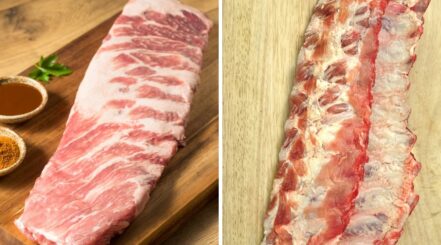
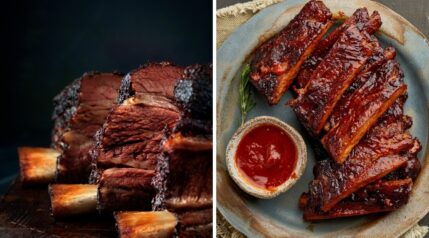
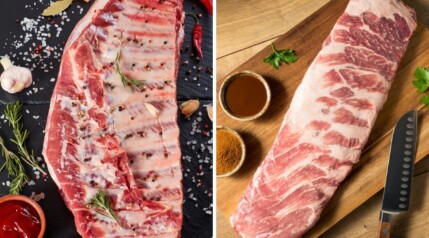
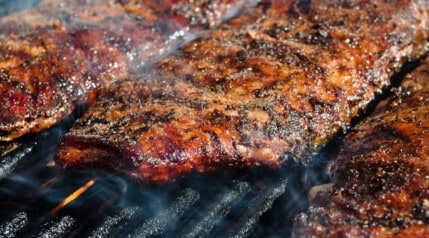
Can you please tell me what “Texas Style Ribs” are? I don’t know if it is a cut of rib or what. I would appreciate any information you could give me!
Hi Debbie,
It’s not a cut a such, more the style of cooking used to cook the ribs, what rubs and what sauces are used.
It can vary, as in Texas they actually have different styles depending on if it’s East, Central, Southern, etc. But generally speaking Texas style is cooked very low n slow, is kept very simple with basic salt and pepper rubs, and has only minimal other ingredients (paprika, maybe a bit of sugar.) They’re known for not being big on sauces and if they do use a sauce, it’s usually on the side, more as a dip than a sauce, and is usually a thin tomato and vinegar style mix.
Also, they are big on beef in Texas, so some people refer to beef ribs as Texas style ribs, but they do also pork ribs of course, so this is not a cert.
Have a quick google for ‘Texas style ribs’, and read some of the recipes available … sadly I’m a few weeks away from getting recipes up on this site which is still fairly new and somewhat still being built!
Hope this helps!
I actually bought Texas style ribs at the grocery store yesterday. That is what they were labeled as. I came across this site trying to find the best way to cook them. I cannot find anything about them. I will ask the butcher next time I go. I realize this is an old thread, but I chose to post anyway.
Hi Connie,
Comments are monitored all the time, and it’s never too late to contribute, on posts old or new 🙂
What you have (I hope!) are Texas cut beef ribs. They are short ribs cut into individual portions, instead of being whole, or a whole rack. I’m afraid I’ve not covered them on this site yet, so for information on how to cook them google ‘Texas cut short rib recipe‘ and you will find many different recipes to follow.
Personally I tend to smoke them for 3 or 4 hours at 225F, then wrap with some liquid (dark beer) for a further 3 or 4 hours, aiming for something like 200f to 210f internal temp, usually on the high side, but going more on feel and making sure if they probe like butter. This point can vary in temp depending on the meat.
Best of luck!
In a west Texas sausage shop they were selling “heavy” ribs. What is the difference between that and regular ribs?
Hi Tommy. Whenever I’ve seen ‘heavy ribs’, they’ve always been simply been untrimmed spare ribs from a larger animal. So untrimmed, making them very meaty, with a bit of an extra flap of meat, and the rib tips all attached, and larger than normal making them very meaty.
I’m unaware of an actual, known definition for what ‘heavy ribs’ are, but that’s what I’ve always seen.
Mark — Thanks, for the article. Going to the kitchen now to try a slow cooker recipe for ribs. When done I’ll put them under the broiler for 5 minutes. We’ll see what happens… 🤔
I was laughing because my sister who loathes cooking used to do Country Ribs in the Crock Pot (Open Pit, High, 4 hrs) and then take them out to the gas grill until they had a nice finish. 25 years before any one mentioned “Reverse Sear”. Lily is basically Planning the same method. Paula’s always came out great.
A friend carried cooked pork ribs to us for dinner. Before cutting, they looked like a regular rack of ribs but had tiny roundish bones throughout with the meat so close to bones it seemed impossible to eat. I felt so bad for her, she worked hard cooking them. What kind of ribs were they as we would like to avoid buying them again.
Hi Gail. It’s very hard to say without actually seeing them I’m afraid. Sometimes a butcher will cut too close to the bone, and produce what we call ‘shiners’, where there is very little meat and sometimes even bones exposed. Could this be it?
Anyhow, to avoid this in future, simply ask for ‘meaty spare ribs / meaty baby back ribs’ and they should be closer to what you want. And of course, inspect them before you buy and reject any where there’s simply not enough meat on the bones.
What are short ribs? Best way to cook them?
I have an article on this that you can find by using the search at the top of this site.
As a complete Newbie, I love pork ribs but up until now relied on the kindnessess of other cooks for delicious ribs – this article was very comprehensive, easy to follow no bbq uppity-ness – and now I too can wrestle with a rack of ribs and be at nobody’s mercy – yum yum and thank you.